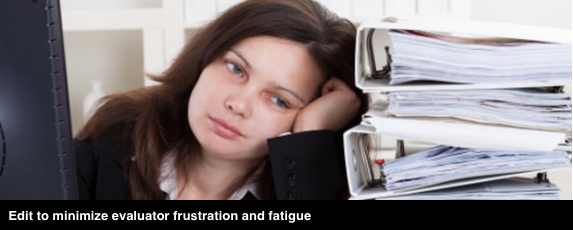Recent posts covered understanding proposal evaluators, and how to use structure, content planning tools and close management to make proposals easy to scan and score.
Editing is the next step in making content as evaluator-friendly as possible.
Structural editing
Structural editors use their understanding of the project and the team’s win strategy to improve selling power and ease of scoring. This work can include:
- Triage: Confirming the draft meets agreed minimum standards of completeness and compliance for editing and returning or escalating substandard drafts.
- Rearranging, merging and/or breaking up paragraphs for greater easy of reading
- Restructuring the logic flow to align with the team’s agreed information architecture, or with good practice (e.g. problem statement, solution, reasoning, proof of past success).
- Cutting low value or repetitive content to meet page limit requirements
- Identifying content gaps and opportunities to connect content with win themes.
- Converting plain text to graphics (illustrations, tables, graphs) and evaluating submitted graphics. (One test: A graphic should convey the desired message in less than 5 seconds.)
- Turning embedded project examples into mini case studies.
- Using subheads or bullet points to break up large text blocks for easier reading.
- Adding callouts to emphasize differentiators.
Structural editing, also called strategic editing, takes a high-level approach to content and makes macro improvements. Depending on the downstream copy editors’ abilities, the structural editor will either make the needed changes or insert comments asking copy editors to make them.
Copy editing
Copy editors work to ensure proposal evaluators to scan and score content without confusion or distractions, for example:
- Increase clarity with edits to use plain language, including short paragraphs, active voice, simple sentence structure, verb forms and words. Use the readability tool built into MS Word and aim for grade 11 reading level or lower.
- Consistency starts aligning heads, bullet styles etc. with the template and using consistent abbreviations and short forms for weights and measures, projects, company names, committee, etc. throughout. Other aspects include single voice (consistent sentence structure and avoiding emotional or idiosyncratic language) and using bullets and lists consistently. On large projects with multiple copy editors, a proposal style guide is an essential aid to consistency.
- Callouts use snippets text boxed or set off in bold type to highlight key benefits and differentiators. Use the same callout style throughout the proposal and—again, for the evaluators’ benefit—place them in the same position on each page.
- Graphics captions should include a clear benefit or “so what” for the evaluator.
- Trigger phrases make it easier for evaluators to identify scorable features by connecting them with their related benefits in a consistent way. To draw attention to strengths and differentiators, lead each with: “A key strength of our solution is . . .” or “A clear benefit of this approach is . . .” or “Only this approach provides . . .”
- Echoing the prospect’s preferred words is another approach to helping evaluators spot scorable items. Begin by analysing the RFP document for most frequently used adjectives and verbs used describing preferred actions and outcomes. For example, if the word “enhanced” appears frequently in the RFP, consider using it instead of synonyms, such as “improved,” “superior,” or “increased.” Compile a list of the top 20 such candidates and (within reason) substitute them for synonyms throughout the response.
Keep your eye on the ball
In making edits, remember that the goal is to help evaluators scan and score your proposal. Clarity of logic and language trumps elegance when it comes to proposals. Unlike your grade 10 English teacher, evaluators are not grading for originality.


